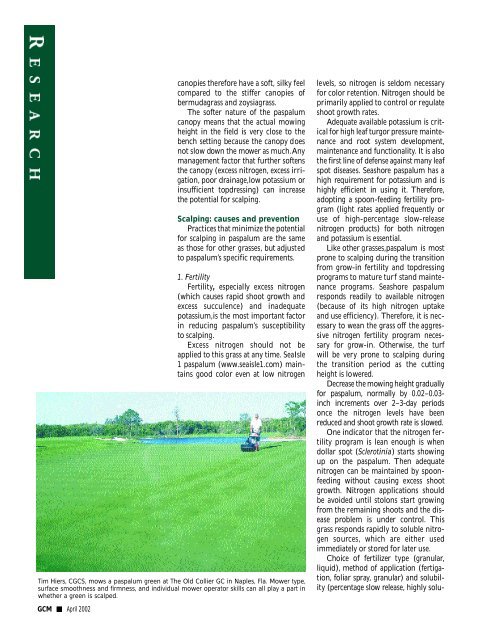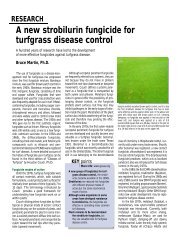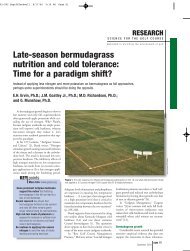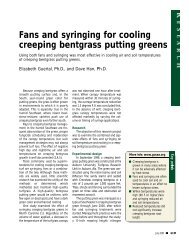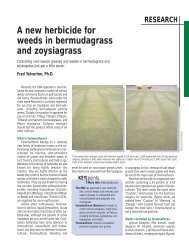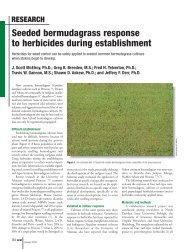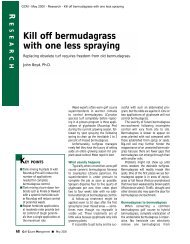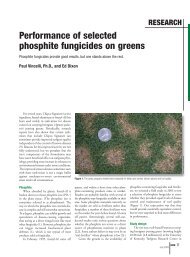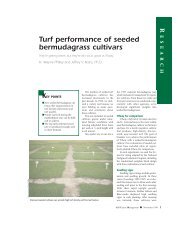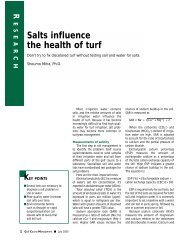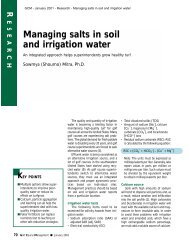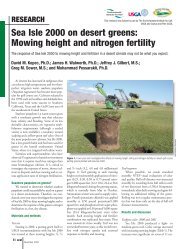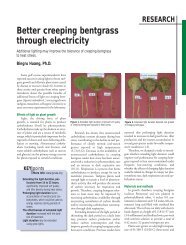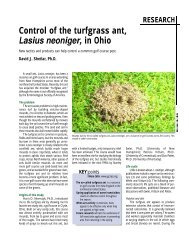Thou shalt not scalp seashore paspalum - GCSAA
Thou shalt not scalp seashore paspalum - GCSAA
Thou shalt not scalp seashore paspalum - GCSAA
You also want an ePaper? Increase the reach of your titles
YUMPU automatically turns print PDFs into web optimized ePapers that Google loves.
GCM April 2002<br />
canopies therefore have a soft, silky feel<br />
com p a red to the sti f fer canopies of<br />
bermudagrass and zoysiagrass.<br />
The softer nature of the <strong>paspalum</strong><br />
canopy means that the actual mowing<br />
height in the field is very close to the<br />
bench setting because the canopy does<br />
<strong>not</strong> slow down the mower as much.Any<br />
management factor that further softens<br />
the canopy (excess nitrogen, excess irrigation,<br />
poor drainage,low potassium or<br />
insufficient topdressing) can increase<br />
the potential for <strong>scalp</strong>ing.<br />
Scalping: causes and prevention<br />
Practices that minimize the potential<br />
for <strong>scalp</strong>ing in <strong>paspalum</strong> are the same<br />
as those for other grasses, but adjusted<br />
to <strong>paspalum</strong>’s specific requirements.<br />
1. Fertility<br />
Fertility, especially excess nitrogen<br />
(which causes rapid shoot growth and<br />
excess su cc u l en ce) and inadequ a te<br />
potassium,is the most important factor<br />
in reducing paspalu m’s su s cepti bi l i ty<br />
to <strong>scalp</strong>ing.<br />
Excess nitrogen should <strong>not</strong> be<br />
applied to this grass at any time. SeaIsle<br />
1 <strong>paspalum</strong> (www.seaisle1.com) maintains<br />
good color even at low nitrogen<br />
Tim Hiers, CGCS, mows a <strong>paspalum</strong> green at The Old Collier GC in Naples, Fla. Mower type,<br />
surface smoothness and firmness, and individual mower operator skills can all play a part in<br />
whether a green is <strong>scalp</strong>ed.<br />
levels, so nitrogen is seldom necessary<br />
for color retention. Nitrogen should be<br />
primarily applied to control or regulate<br />
shoot growth rates.<br />
Adequ a te ava i l a ble po t a s s ium is cri t-<br />
ical for high leaf tu r gor pre s su re mainten<br />
a n ce and root sys tem devel opm en t ,<br />
m a i n ten a n ce and functi on a l i ty. It is also<br />
the first line of defense against many leaf<br />
s pot diseases. Se a s h ore <strong>paspalum</strong> has a<br />
h i gh requ i rem ent for po t a s s ium and is<br />
h i gh ly ef f i c i ent in using it. Th erefore ,<br />
adopting a spoon - feeding ferti l i ty program<br />
(light ra tes app l i ed frequ en t ly or<br />
use of h i gh - percen t a ge slow - rel e a s e<br />
n i trogen produ cts) for both nitrogen<br />
and po t a s s ium is essen ti a l .<br />
Like other grasses,<strong>paspalum</strong> is most<br />
prone to <strong>scalp</strong>ing during the transition<br />
from grow-in fertility and topdressing<br />
programs to mature turf stand mainten<br />
a n ce progra m s . Se a s h ore paspalu m<br />
responds readily to available nitrogen<br />
(because of its high nitrogen uptake<br />
and use efficiency). Therefore, it is necessary<br />
to wean the grass off the aggressive<br />
nitrogen fertility program necessary<br />
for grow-in. Otherwise, the turf<br />
will be very prone to <strong>scalp</strong>ing during<br />
the tra n s i ti on peri od as the cut ti n g<br />
height is lowered.<br />
Dec rease the mowing hei ght gradu a lly<br />
for paspalu m , n orm a lly by 0.02–0.03-<br />
i n ch increm ents over 2–3-day peri od s<br />
once the nitrogen levels have been<br />
redu ced and shoot growth ra te is slowed .<br />
One indicator that the nitrogen fertility<br />
program is lean enough is when<br />
dollar spot (Sclerotinia) starts showing<br />
up on the <strong>paspalum</strong>. Then adequate<br />
nitrogen can be maintained by spoonfeeding<br />
without causing excess shoot<br />
growth. Nitrogen applications should<br />
be avoided until stolons start growing<br />
from the remaining shoots and the disease<br />
problem is under control. This<br />
grass responds rapidly to soluble nitrogen<br />
source s , wh i ch are ei t h er used<br />
immediately or stored for later use.<br />
Ch oi ce of ferti l i zer type (gra nu l a r,<br />
l i qu i d ), m et h od of a pp l i c a ti on (ferti gati<br />
on , foliar spray, gra nular) and solu bi l-<br />
i ty (percen t a ge slow rel e a s e , h i gh ly solu-


